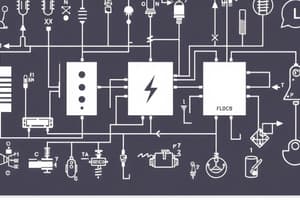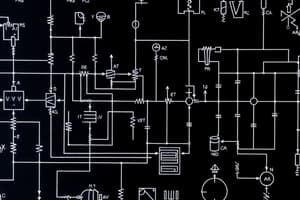Podcast
Questions and Answers
In a circuit diagram, symbols represent electronic components.
In a circuit diagram, symbols represent electronic components.
True (A)
What does SPST stand for?
What does SPST stand for?
- Single-pole single-throw (correct)
- Standard-pole switch technology
- Single-pole double-throw
- Simple-pole switching terminal
The longer line in a voltage source symbol indicates the ______ terminal.
The longer line in a voltage source symbol indicates the ______ terminal.
positive
What is the purpose of a circuit diagram?
What is the purpose of a circuit diagram?
Match the following circuit symbols with their corresponding components:
Match the following circuit symbols with their corresponding components:
Which of the following components has a voltage-independent resistance?
Which of the following components has a voltage-independent resistance?
The relationship between voltage and current is called a characteristic curve.
The relationship between voltage and current is called a characteristic curve.
What is the abbreviation for a resistor with a lower resistance at higher temperatures?
What is the abbreviation for a resistor with a lower resistance at higher temperatures?
The formula for calculating resistance is ______ = Voltage / Current
The formula for calculating resistance is ______ = Voltage / Current
Match the following components with their corresponding characteristics:
Match the following components with their corresponding characteristics:
The SI unit for electric current is the Coulomb.
The SI unit for electric current is the Coulomb.
The electric current is defined as the amount of charge flowing through a conductor in a given ______.
The electric current is defined as the amount of charge flowing through a conductor in a given ______.
What is the physical direction of current flow for a negative charge?
What is the physical direction of current flow for a negative charge?
Which of the following statements is TRUE regarding the conventional current direction?
Which of the following statements is TRUE regarding the conventional current direction?
Match the following terms with their corresponding units:
Match the following terms with their corresponding units:
The physical current direction is always the same as the technical current direction.
The physical current direction is always the same as the technical current direction.
Explain why it's important to define a conventional current direction.
Explain why it's important to define a conventional current direction.
An ohmic resistor has a resistance that is ______ for varying the applied voltage.
An ohmic resistor has a resistance that is ______ for varying the applied voltage.
A nonohmic resistor has a resistance that does not change when the applied voltage changes.
A nonohmic resistor has a resistance that does not change when the applied voltage changes.
If you increase the time it takes for a certain amount of charge to flow through a conductor, what happens to the current?
If you increase the time it takes for a certain amount of charge to flow through a conductor, what happens to the current?
In a typical metallic conductor, the charge carriers responsible for electric current are ______.
In a typical metallic conductor, the charge carriers responsible for electric current are ______.
Which of the following is NOT a method for generating different voltages in a circuit?
Which of the following is NOT a method for generating different voltages in a circuit?
What are the two main types of components that can convert electrical energy into other forms of energy?
What are the two main types of components that can convert electrical energy into other forms of energy?
Match the following terms with their definitions:
Match the following terms with their definitions:
A light bulb is an example of an ohmic resistor.
A light bulb is an example of an ohmic resistor.
What is the relationship between resistance and current in an ohmic resistor?
What is the relationship between resistance and current in an ohmic resistor?
What type of energy conversion occurs when an electric motor is operating?
What type of energy conversion occurs when an electric motor is operating?
The ______ is a measure of how much electrical energy is converted into another form of energy per unit of time.
The ______ is a measure of how much electrical energy is converted into another form of energy per unit of time.
A battery rated at 15 Ah can deliver a current of 3 A for 5 hours.
A battery rated at 15 Ah can deliver a current of 3 A for 5 hours.
What is the unit of measurement for power in electrical circuits?
What is the unit of measurement for power in electrical circuits?
A home electrical socket typically has three holes, which are used for ______, ______, and ______.
A home electrical socket typically has three holes, which are used for ______, ______, and ______.
Match the following electrical quantities with their respective units of measurement:
Match the following electrical quantities with their respective units of measurement:
Which of the following is NOT a safety measure used in home electrical installations?
Which of the following is NOT a safety measure used in home electrical installations?
Flashcards
Circuit Symbols
Circuit Symbols
Standardized symbols for electronic components in a circuit diagram.
Circuit Diagram
Circuit Diagram
A graphical representation of an electrical circuit.
Voltage Source
Voltage Source
Component providing electrical energy in a circuit.
Electric Current
Electric Current
Signup and view all the flashcards
SPST Switch
SPST Switch
Signup and view all the flashcards
SPDT Switch
SPDT Switch
Signup and view all the flashcards
Closed Circuit
Closed Circuit
Signup and view all the flashcards
Ampere-hour (Ah)
Ampere-hour (Ah)
Signup and view all the flashcards
Energy stored in battery
Energy stored in battery
Signup and view all the flashcards
Electricity cost
Electricity cost
Signup and view all the flashcards
Home electricity current type
Home electricity current type
Signup and view all the flashcards
Speaker system overload protection
Speaker system overload protection
Signup and view all the flashcards
Electric current (I)
Electric current (I)
Signup and view all the flashcards
SI unit of current
SI unit of current
Signup and view all the flashcards
Charge types
Charge types
Signup and view all the flashcards
Physical current direction
Physical current direction
Signup and view all the flashcards
Technical current direction
Technical current direction
Signup and view all the flashcards
Effect of increased charge on current
Effect of increased charge on current
Signup and view all the flashcards
Effect of decreased time on current
Effect of decreased time on current
Signup and view all the flashcards
Decrease in current effect
Decrease in current effect
Signup and view all the flashcards
Charging current calculation
Charging current calculation
Signup and view all the flashcards
Voltage Divider
Voltage Divider
Signup and view all the flashcards
Ohmic Resistor
Ohmic Resistor
Signup and view all the flashcards
Nonohmic Resistor
Nonohmic Resistor
Signup and view all the flashcards
Resistance Measurement
Resistance Measurement
Signup and view all the flashcards
Electrical Energy Conversion
Electrical Energy Conversion
Signup and view all the flashcards
Ohm's Law
Ohm's Law
Signup and view all the flashcards
Characteristic Curves
Characteristic Curves
Signup and view all the flashcards
Resistor Identification
Resistor Identification
Signup and view all the flashcards
Electrical Motor
Electrical Motor
Signup and view all the flashcards
LED
LED
Signup and view all the flashcards
NTC Resistor
NTC Resistor
Signup and view all the flashcards
PTC Resistor
PTC Resistor
Signup and view all the flashcards
Varistor
Varistor
Signup and view all the flashcards
I-U Diagram
I-U Diagram
Signup and view all the flashcards
R-U Diagram
R-U Diagram
Signup and view all the flashcards
Voltage-Current Pair
Voltage-Current Pair
Signup and view all the flashcards
Study Notes
Electric Circuit Study Notes
- This document is a set of study notes on electric circuits, specifically covering concepts, exercises, and labs.
- The document spans multiple pages.
- The document covers topics like simple electric circuits, current, voltage, resistance.
- It delves into the concepts of circuit diagrams, various circuit components (like switches, resistors, and bulbs), series and parallel circuits, measurement of electrical quantities (using a multimeter), and practical applications such as home electricity and safety.
- The exercises and labs are designed to reinforce theoretical concepts with hands-on applications.
- The document includes several exercises and examples related to circuit design, analysis, and measurement.
- It includes a section on voltage sources, resistors in series/parallel, and measurement using a multimeter, encompassing voltage, current, and resistance.
- It contains sections on EveryCircuit, a circuit analysis tool, explaining its use in circuit design and analysis.
- It guides on building different types of circuits, including those with bulbs, switches, and various resistor combinations (series and parallel) and includes exercises to test understanding.
- A section on safety measures is present, discussing the importance of protecting oneself from electrical shocks, and common safety procedures in electrical setups.
- The study notes also include definitions of terms like electric current, voltage, and resistance, as well as examples of how to apply these concepts.
- The document contains diagrams, illustrations, and tables to aid understanding.
- The document emphasizes practical applications like installing a bulb in a socket and safety procedures.
- The document offers a set of exercises for students to practice.
Studying That Suits You
Use AI to generate personalized quizzes and flashcards to suit your learning preferences.




